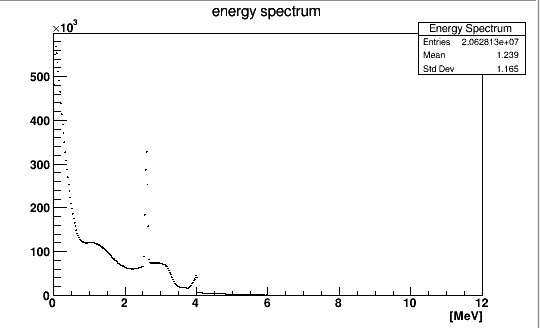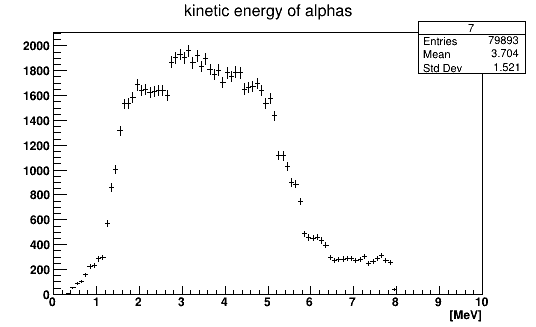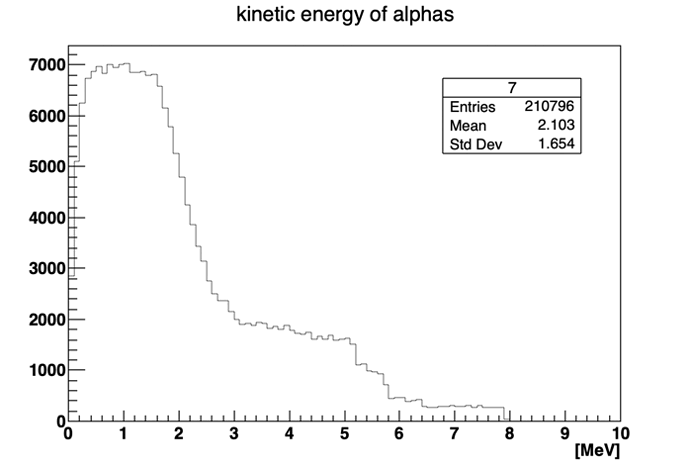I build a 12C target , I want to research the C12(n,α)Be9 reaction. I record the deposit energy in every event, and get the deposit Energy Spectrum, but , I can not find a peak
of 8.299MeV which is the energy of the C12(n,α)Be9 reaction. I use the QGSP_BERT_HP model and I have tried different data library, but I can not make it.
I don not why, what should I do? Can you help me?

Hello,
I am facing the same problem.
Up ![]()
It’s not obvious to me that there is anything wrong with the deposited energy plot. The Q value of the 12C(n,alpha)9Be reaction is -5.702MeV. “the energy of the reaction” is a very vague phrase, but I’m assuming that what the first poster meant is that the energy of the incident neutron is 8.299MeV (target at rest). Thus, the total deposited energy should be ~2.597MeV and I see a peak roughly there. The rest of the spectrum is not unreasonable, given all the 12C(n,…) reaction channels that are available at that energy.
A more detailed description of the geometry, reaction, energies, and what is trying to be measured is needed to assess if there is anything wrong with the physics.
Thanks for the reply @John_McFee
Actually I should have add more information about my problem.
I am studying several n,alpha reactions for several materials.
The kinetic energy distributions of the products are correct using QGSP_BERT_HP
However, I obtained one strange result with the n,alpha reaction on Carbon. Instead of having a distribution of the kinetic energy (Observed with other code like PHITS) I observed with Geant a cut at 2.5 MeV in my kinetic energy distribution for 14 MeV impinging neutrons (only for the n,alpha on carbon). Could it be a problem with the nuclear data ?
Hi All, I find this topic interesting and i want to place some suggestions which can be worth.
In Geant4 especially when dealing with neutron kinetic energy < 20 MeV the process undergoes in four ways. Elastic, Inelastic, Radiative capture, and fission. And all calculations done under environmental variable G4NEUTRONDATA with data libraries G4NDL4.6 and is based on JEFF-3.3
Previous data files were based on ENDF/B. I guess you please check it once and its version as JEFF provides closest agreement with MCNP results.
My other suggestion is to test your case using QGSP_BIC_HP → This certainly use binary cascade method. I am not sure this will increase accuracy in the calculations but will be worth to compare the results.
You may also compare the data libraries of both softwares’. I guess they also use the JEFF but I am not sure.
Regards
Here, a run of example Hadr03, with QGSP_BIC (not _HP) in PhysicsList.cc
The difference comes from the dissociation C12 → 3 alphas, which does not exist in HP
name.mac.txt (381 Bytes)
name.bic.out.txt (1.7 KB)
Hi Michel, There is a slightly puzzling thing going on in your (or my) output using QGSP_BIC. My plot and terminal output is attached. From the latter, it is clear that mine has the neutron + C12 → neutron + C12 reaction whereas yours has the neutron + C12 → neutron + 3 alpha.
I am running Geant4 11.0.2 and the Hadr03 example from that distribution recompiled with QGSP_BIC (not _HP) with your (unmodified) name.mac. I assumed we would get the same result. Is there something different in the (apparently) newer version of Geant4 that you are running?

name.mybic.out.txt (25.9 KB)
Thank you @drvijayraj , @John_McFee, @maire for your reply.
I have changed my physicslist from QGSP_BERT_HP (although it is intended for the purpose of simulating neutron with E<20MeV which is what I am interested in) to QGSP_BIC (not _HP).
I find this time the right kinetic energy distribution for the alphas produced in C(n,alpha)9Be.
However :
- I don’t get the kinetic energy distribution of the gamma produced in C(n,a)Be anymore, while I still get it for the other capture reactions on other nuclei.
- I get a lower count rate for this C(n,alpha) than the one obtained with BERT_HP (seems normal) but, I now obtain alpha+8Be+n produced in some events (with higher count rate than C(n,alpha)9Be), which was not expected.
- Finally, I get a kinetic energy distribution this time, in another (n,alpha) reaction on another nuclei, with lower energy boundaries than the ones expected.
Thank you again for the discussion.
N.B. : I am using geant4 11.0.2
HI John, thanks you have noticed this difference. I have sent a mail to the maintener.
Hello everyone,
I, too, encounter the same problem as @qu246 .
I’m simulating fast (14 MeV) neutrons interacting with carbon and silicon. My interest is the energy deposited by the neutron (and its charged products) Ed in my sensitive volume.
What I expect to find with Silicon-28 is the reaction 28Si(n,a)25Mg producing an alpha and a Mg ion with a energy (summed) of 11.35 MeV. Sometimes the 25Mg will be on the fundamental atomic state and will, thus, deposit the entirety of 11.35 MeV in the detector (creating a peak at 11.35 MeV). Some other times the 25Mg will be on an excited state, producing one (or more) gammas that will not be detected by my detector: this will cause the Ed to be less than 11.35 MeV (since the gamma brought away some of it).
This expectation is fully verified: I can find multiple peaks for the 28Si(n,a)25Mg reaction, corrisponding to the energies of the various excited states of the 25Mg. For example: I find a peak at Ed = 11.35 MeV corresponding to the ground state, a peak at Ed = 11.35-0.58 = 10.77 MeV corresponding to the first excited state (with 0.58 MeV being the energy of the first excited state), etc.
The same is not true for 12C. In fact, I expect to find the 12C(n,a)9Be (ground state) peak at Ed = 8.3 MeV, but I can’t find it. The same is true for other reactions involving charged products (e.g. 12C(n,n+a)8Be), while the simple scattering reactions (12C(n,n)12C) work just fine.
I investigated further the matter: I found out that the reactions 12C(n,a)9Be do happen in the simulation, but they’re always come with a production of gammas and electrons (most of the time its four gammas and two electrons). The production of just an 9Be+alpha seems to never occur - while, from my experience on diamond detectors, it should be prevalent.
I’m still struggling to find a solution, and I’ll be happy to receive your help if you can give me some. I hope my investigation might be of some help…
Additional info:
- My geant4 version name is 10-07-patch-02.
- I used both QGSP_BERT_HP and QGSP_BIC_HP and the results were similar. I also tried the non-HP versions, but the results were completely off for the silicon.
- I used the ENDF-VIII.0 library, the ENDF-VI8 library and the G4NDL4.6 library, all with similar results.
Thank you in advance!
Hello,
I am also simulating 14MeV neutrons interacting with diamond targets and I would like to collect the energy deposited by neutrons and their products, but I’m encountering the same issues described in this post. I expect to see a broad peak for the 12C(n,3alpha) reaction and a 12C(n,alpha)9Be peak. Depending on the physics list used, I either see neither of these peaks, or the 12C(n,3alpha) peak dominates, whereas I expect the 12C(n,alpha)9Be reaction to dominate based on real diamond detector measurements I have made.
I edited the DetectorConstruction file in basic example B4d to make the absorber material diamond and the gap material air, and changed the source particles in the example macro (run1.mac) to 14.1MeV neutrons and commented out the rest of that macro. Then, I observe the results using the provided plotHisto.C histograms for energy deposited in the absorber.
These are the physics lists that I have tried:
FTFP_BERT: (n,3alpha) broad peak present, no 12C(n,alpha)9Be peak
FTFP_BERT_HP: neither (n,3alpha) nor 12C(n,alpha)9Be are visible
QGSP_BIC: Both peaks are visible, but the height of the (n,3alpha) peak is about twice the height of the 12C(n,alpha)9Be peak, whereas the reverse is true of my real diamond detector measurements.
QGSP_BIC_HP: neither (n,3alpha) nor 12C(n,alpha)9Be are visible
QBBC: Results similar to those of QGSP_BIC
I would appreciate any advice on this topic.
Please let me know if more information is needed.
Thanks!
_Geant4 Version:_11.2.2
_Operating System:_Ubuntu 22.04.4 LTS on WSL2
_Compiler/Version:_gcc/g++ 11.4.0
_CMake Version:_3.22.1
_HP uses the cross sections from file $G4NEUTRONHPDATA/Inelastic/F02/6_nat_Carbon.z , which is the JEFF-3.3
You can see the Geant4 guide to understand its format
Thanks for your response. On the advice of a colleague, I added this line to the macro:
/process/had/particle_hp/use_NRESP71_model true
This has resolved the issue for me.
